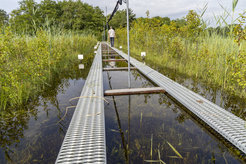Avian Migration

In my role as Max Planck Fellow at MPI-AB since 2020, I have helped to resume a globally unique, long-term study of migrating birds on Lake Constance. Started in 1972 by former MPI Director Peter Berthold, the study ran annually on the Mettnau peninsula, an important stopover site for birds on the western side of the lake. Each season from June 30 to November 6, more than 50 nets were placed along a stretch of habitats ranging from dense scrub to reed beds. Nets were always set in the same manner and controlled at each full hour from the beginning of civil twilight in the morning to the end of civil twilight in the evening. The program aimed to study long-term population dynamics, phenology, and physiology of songbird migrants, as well as ecological aspects of migrants such as habitat use and food preference at a stopover site. It produced many influential publications and set standards for similar trapping projects that followed elsewhere. The program ran until 2008.
On June 30, 2022, on the 50-year anniversary of its 1972 inception, the program was re-launched on Mettnau according to original protocols. The trapping effort ran for three years (2022-2024), extending findings from the original study and offering a window into migratory behavior of 32 species across half a century. In particular, we are looking for changes in the phenology of autumn passage, external morphology (wing length), and conditional measures (body mass, fat score). These standardized long-term data will provide crucial insight into how Germany’s migratory birds are faring under stressors like climate change.
